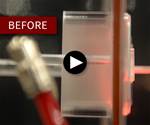New Test Method Analyzes Gas Formation in Molding
Resin maker Polyplastics says the proprietary method captures and evaluates gases formed during injection molding.
Engineering thermoplastics supplier Polyplastics has developed a test method that identifies gas formation during injection molding and ultimately may help reduce mold deposits. Dubbed Gas Investigation Method in Injection Molding (GIMIM), the concept entails the addition of gas traps at each stage of molding: plastication, metering, and injection. Once captured, gas chromatography mass spectrometers (GC/MS) are used to qualitatively and quantitatively analyze the gases produced in the various plastication stages. For now, Polyplastics is using GMIM for internal research to better determine the causes of mold deposits.
The high speeds, temperatures and pressures of injection molding can lead to the deterioration of plastic additives and the subsequent release of decomposition gases. Mold deposits, gas burns, and short shots caused by pyrolysis gas create quality issues and higher defect rates. Polyplastics lays out the negative cycle that offgassing can create where the presence of mold deposits, gas burns and short shots leads to the installation of larger vents on the tool. These larger vents can lead to flashing, forcing the vents to be reduced in size, which once again creates gas issues within the tool.
GIMIM makes it possible to measure high-molecular-weight substances that can cause mold deposits. Since this method directly analyzes gases that are formed inside the mold during filling, the company believes it yields results that are closest to real-world conditions.
GIMIM makes it possible to measure high-molecular-weight substances that can cause mold deposits
Prior to GIMIM, ascertaining the source and output of pyrolysis gas largely fell to two methods, neither of which captured the actual conditions in the tool. One method involved heating pellets and analyzing the resulting volume and composition of decomposition gases. The other technique involved running a tool and material and then analyzing the resulting mold deposits that adhered to the mold.
In its research, Polyplastics looked specifically at physical and chemical adsorption: In the former, mold deposits are adsorbed to positively charged metal surfaces; in the latter, electrons are shared between surface-layer atoms in covalent bonds and hydrogen bonds. In further research, Polyplastics plans to examine other problems caused by pyrolysis gas, such as short shots and gas-burn defects, as well as mold deposits.

The GIMIM concept entails the addition of gas traps at each stage of molding: plastication, metering, and injection.
Related Content
-
Air Ring Add-On Brings Output to New Level
The Short Stack from Addex sits between the air ring and die and provides high-velocity air flow to boost output and lock in the bubble.
-
Cobot Creates 'Cell Manufacturing Dream' for Thermoformer
Kal Plastics deploys Universal Robot trimming cobot for a fraction of the cost and lead time of a CNC machine, cuts trimming time nearly in half and reduces late shipments to under 1% — all while improving employee safety and growth opportunities.
-
Captive Molder Beefs Up Auxiliaries to Boost Quality, Consistency
SeeScan adds conveying, drying, feeding and chilling technologies to improve quality — and enhance employee safety — in production of its underground/underwater inspection systems.










.png;maxWidth=300;quality=90)





